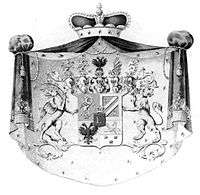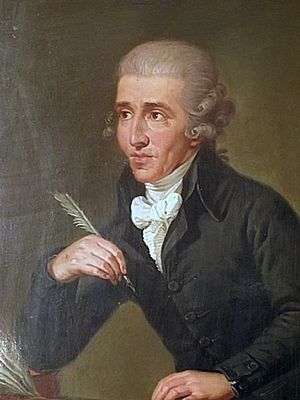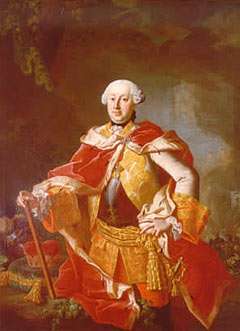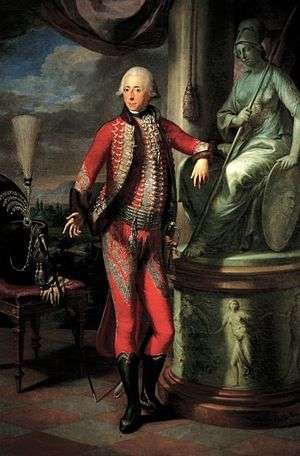House of Esterházy


The House of Esterházy (also spelled Eszterházy, Hungarian pronunciation: [ˈɛstɛrhaːzi]) is a Hungarian noble family beginning in the Middle Ages.[1][2][3][4] Since the 17th century they were among the great landowner magnates of the Kingdom of Hungary, during the time it was part of the Habsburg Empire and later Austria-Hungary. During the history of the Habsburg empire, the Esterházys were consistently loyal to the Habsburg rulers. They received the title of count in 1626 and the Forchtenstein line received the title of Fürst (Ruling Prince) by the Holy Roman Emperor in 1712.
History
The Esterházys arose among the minor nobility of the northern part of the Kingdom of Hungary (today's southwest Slovakia), originally a branch of the Salamon clan (de genere Salamon) by the name Zerházi (de Zerhásház / de Zyrház / de Zyrhas). Their first known ancestors were Mokud (Mocud) from the Salamon clan, who was a military serviceman and landowner in the Csallóköz region of Western Hungary (today Žitný ostrov in southwestern Slovakia), and Pristaldus, a judicial office-holder in the court of Béla III of Hungary.[5]
The name Esterházy was first used by Benedict Zerhas de Zerhashaz (1508–1553), who in 1539 took over the wealth of his wife Ilona Bessenyei de Galántha. Their son, Ferenc Esterházy (1533–1604) inherited the coat of arms and title of his mother and the full name of the family became Eszterházy de Galántha, Galanta being a small town east of Bratislava (Hungarian: Pozsony, German: Pressburg), now capital of Slovakia.
The family rose to prominence under Count Nikolaus Esterházy (1583–1645) and his son, Prince Paul Esterházy (1635–1713). In the 17th century, after Nikolaus' acquisitions, the family split into four main family lines:
- the older Forchtenstein (Hungarian: Fraknó) line: founded by Nikolaus Esterházy, main seat: Eisenstadt (Kismarton)
- the younger Forchtenstein line
- the Zólyom line: founded by Paul Esterházy (died 1645)
- the Csesznek line: founded by Daniel Esterházy (died 1654)
In 1626 the Esterházys were granted the title of Count and in 1712, the older Forchtenstein line received the title of (Ruling) Prince by the Holy Roman Emperor.
The success of the family arose from the steady accumulation of land, and loyalty both to the Roman Catholic Church and to the Habsburg Emperor. The latter factor was perhaps the most important. A consistent theme of Hungarian history was an ardent and sometimes violent wish to become free of Austrian rule, a wish that was finally fulfilled at the end of the First World War. The Esterházy princes were consistently loyal to the Habsburg monarchy, and on several occasions rendered vital services to it in times of crisis. These included the Turkish siege of Vienna in 1683, and the outright occupation of Vienna by Napoleon in 1809.
The family acquired its property in three principal ways: redistribution of land taken from Protestants in the Counter-Reformation, redistribution of land conquered from the Turks, and felicitous marriages.[6] Most of these lands were situated in present-day Austria, Slovakia and Hungary. The family ultimately became the largest landowners in the Habsburg Empire, and their income sometimes exceeded that of the Emperor.
Residences


The family derived its name from the settlement Esterháza, Kingdom of Hungary. The settlement no longer exists, and is not to be confused with the later castle of the same name which they inhabited since the Middle Ages. Since 1421 they have been the owners of a property in Galanta.
The most important seat of the Esterházys was Eisenstadt (Hungarian: Kismarton), since the heads of the family chose to make a castle in this tiny village their primary residence. A fortified stronghold had been built there in the 14th century; after the Esterházys acquired it they rebuilt it 1663–1672 to what is now the princely Schloss Esterházy. Their practical reason for choosing to create and maintain the princely court at Eisenstadt may have been that while the region was in Hungary, it had been mainly settled by Germans, and was situated rather close to the Habsburgs' Imperial residence, Vienna. (The region remained part of Hungary until 1921, when it was handed over to Austria according to the Treaty of Saint-Germain, 1919, and the Treaty of Trianon, 1920.)
The Esterházys maintained a number of other residences throughout the Kingdom of Hungary and Transylvania, and those Esterházy princes who preferred the stylish life of the capital spent most of their time in Vienna. In the 1770s, Prince Nikolaus Esterházy, who disliked Vienna, had a magnificent new palace constructed in Fertőd, Hungary. It was built on the site of a former hunting lodge. This is the most admired of the Esterházy homes, often called the "Hungarian Versailles."

Nomenclature
The main line of the Esterházy family was generally bilingual, in Hungarian (as a result of their ethnicity) and German (as they were aristocrats of the Austrian Empire). Esterházys living in parts of the Kingdom of Hungary where other languages were spoken by the population also spoke those languages, especially Slavic languages in Slavic areas. Some family members went by both Hungarian and (rather distinct) German names. Thus, Pál Antal (Hungarian) was the same person as Paul Anton (German), and Miklós József was the same person as Nikolaus Josef. In discussions written in English, the Esterházy princes are occasionally given English versions of their names, as in "Nicholas".
The family name is also rendered variously: Eszterházy (Hungarian spelling), Esterházy (German), and Esterhazy (typographic convenience). The full family name since the 16th century was Eszterházy de Galántha (later also styled von/of Galanta). The Latinised form of the family name, Estoras, in 2009 is used to label fine Esterházy wines.
Haydn

The Esterházy family is known for its association with the composer Joseph Haydn, who served as their Kapellmeister. Haydn was hired by Prince Paul Anton in 1761, and from 1762 to 1790 served under Paul Anton's successor Nikolaus. During the following reign, that of Prince Anton (1790–1794), the Esterházy family mostly did without the services of musicians, and Haydn, retained on a nominal appointment, spent most of this time in trips to England. Finally, during the reign of Nikolaus II, Haydn worked for the family on a part-time basis. He spent his summers in Eisenstadt and annually composed a mass for the name day of the Prince's wife (and Haydn's friend), Princess Maria Josepha Hermenegild (1768–1845). Haydn continued to perform these duties until his health failed in 1802.
The lines of the family
The first prominent member of the family was Ferenc Zerházy (1563–1594), who was elevated to the title of baron of Galántha (an estate his family had held since 1421) and took the name Esterházy. Family history since this time is described according to three lines of descent, each originating in one of Ferenc's sons: the Fraknó (or Forchtenstein) line, the Csesznek line, and the Zólyom line.[7]
The Fraknó (Forchtenstein) line
The Fraknó (Forchtenstein) line became "the most prominent of the three".[7] In the discussion that follows, Hungarian names are given in brackets.
Count Nikolaus [Miklós] (1583–1645)
- Main article : Nikolaus Esterházy de Galántha
Nikolaus was born in Galanta. Raised as a Protestant, he later converted to Catholicism. Created Count by the Emperor in 1626, he achieved great wealth in part by marrying (twice) into money.
In 1625, Nikolaus was elected Palatine of Hungary, the King's chief lieutenant within Royal Hungary. Nikolaus laid out what became the long-term family strategy, allying himself with the Catholic religion and the Habsburg emperor. He fought against the Protestant champions Gábor Bethlen and György Rákóczi and sought to free Hungary from Turkish domination.[7]

Prince Paul [Pál] (1635–1713)
- Main article: Paul I, 1st Prince Esterházy of Galántha
Paul was the third son of Nicholas, born in Eisenstadt. Elected Palatine in 1681 and created Prince of the Holy Roman Empire (in Hungary the title of Prince did not exist till the 20th century) in 1687 by the Emperor. Paul was a poet, a harpsichordist, and a composer; a number of his cantatas survive; see Harmonia Caelestis. He also wrote a number of religious works. Under Paul the palace in Eisenstadt was rebuilt. Paul served as commander of troops in southern Hungary, during the struggle against the Turks, starting in 1667,[7] and his troops were among the coalition that raised the siege of Vienna in 1683. He also played an important role in suppressing the autonomy of the existing Hungarian nobility.

The line that descended from Paul, the first Esterházy prince, is given as in the following figure. The sequence of princes that follow him continues below.

Prince Michael [Mihály] (1671–1721)
Son of Paul, he was the first to benefit from a 1712 decree of Emperor Charles VI, which made the title of Prince hereditary among the Esterházys. Under him, the family seat at Eisenstadt evolved into a provincial musical center. He died 24 March 1721.[6]
Prince Joseph [József Simon Antal] (1688–1721)
Half-brother of Michael, he reigned for only 11 weeks, as he died on 7 June 1721.[6] As his son Paul Anton was only ten, authority was assigned to two regents: Count Georg Erdödy,[6] and his widow Maria Octavia (c. 1686 – 1762). The latter was responsible for introducing the German language to the court.
Prince Paul Anton [Pál Antal] (1711–1762)
Son of Joseph. In his youth he studied in Leyden[6] and also served as a soldier, rising to the rank of Field Marshal. He served as imperial ambassador to Naples from 1750 to 1752, and traveled extensively.[8]
Paul Anton was a musical prince; he played the violin, the flute, and the lute, and compiled a large inventory of musical manuscripts. Paul Anton also played an important role as a patron of music. In 1728, his mother Maria Octavia, "probably at her son's instigation"[6] engaged the composer Gregor Werner to be the family's Kapellmeister (music director), a post in which Werner served for several decades. Much later (1761), Paul Anton engaged Joseph Haydn to be his Vice-Kapellmeister in 1761, taking over most of the aging Werner's duties. At the same time, he upgraded the court orchestra, hiring several virtuosi who served under Haydn; the composer recognized their ability by writing many solo parts in his early symphonies.[8]

Prince Nikolaus "the Magnificent" [Miklós József] (1714–1790)
Son of Joseph, in his youth a decorated soldier. He was the primary patron of Haydn and builder of Esterháza (see above).

Prince Anton [Antal] (1738–1794)
Son of Nikolaus I, married first, in 1763, Maria Theresia Gräfin Erdödy e Monyorokerek et Monoszlo (1745–1782), and second, in 1785 Maria Anna Gräfin von Hohenfeld (1768–1848). He was elevated to the status of Prince (Fürst) in 1783. He received the Order of St. Stephen in 1777. He was Captain of the Hungarian Noble Life Guard from September 1791 until his death in 1794, and commanded an autonomous corps on the Upper Rhine at the beginning of the War of the First Coalition. His Corps participated in various actions between July and October, 1792, after which he received the Commanders Cross of the Order of St. Stephen. His corps was later absorbed into other military formations. He was Colonel and Proprietor (Inhaber) of the 31st Infantry Regiment, from November 1777 to October 1780, and then Proprietor and Colonel of the 34th Infantry Regiment, from September 1780 until his death. He was initiated to the Order of the Golden Fleece in 1790, and also became an imperial Chamberlain.[9] He disbanded the Esterházy musical establishment for the duration of his reign.
Prince Nikolaus II [Miklós Ferdinánd] (1765–1833)
Born in Vienna, on 12 December 1765, he was the son of Anton and his first wife Maria Theresia. He became reigning Prince on the death of his father in 1794.
Like several of his predecessors Nikolaus II pursued a military career. He is remembered for his amassing a large art collection, for his musical patronage of Haydn and Beethoven, for his sexual debauchery, and for his high expenditures. Ultimately these led to the family being placed under a sequestration order, roughly the equivalent of bankruptcy.

Prince Paul Anton III [Pál Antal] (1786–1866)
Main article: Pál Esterházy
Served Austria in a series of diplomatic posts, and in 1848 was briefly Foreign Minister.
The family encountered financial trouble during his reign, and (according to the 1911 Encyclopædia Britannica), "the last years of his life were spent in comparative poverty and isolation, as even the Esterházy-Forchtenstein estates were unequal to the burden of supporting his fabulous extravagance and had to be placed in the hands of curators."

Prince Nikolaus III [Miklós Pál] (1817–1894)
Main article: Nicholas III, Prince Esterhazy
Owing to financial trouble, Nikolaus III sold the family art collection "on generous terms" to the Austro-Hungarian state in 1870. The collection is, as a result, on public view today in the Museum of Fine Arts in Budapest.[10]
Prince Nikolaus IV [Miklós Pál] (1869–1920)
The reign of Nikolaus IV was a time of revival for the Esterházy family fortunes. The family estates were made into flourishing businesses, including a "traditional welfare net, providing security for employees."[11] With the resulting improvement in the family finances, the family properties were finally released from decades of sequestration.[12] In addition, the family palaces—including the long-abandoned Esterháza—were restored and provided with modern plumbing and electricity.[12] In these efforts Nikolaus was greatly assisted by his wife, Princess Margit (1874–1910), née Countess Csiráky.[12]
Prince Paul [Pál Maria Alois Antal Miklós Victor] (1901–1989)
The lifetime of this prince witnessed momentous, often catastrophic changes for the Esterházy family. At the end of the First World War, the Austro-Hungarian Empire was split up, and the family's land holdings thus came to be located in several different countries.
In 1938, the legal instrument of fideicommiss, allowing to hold family property in foundations owned by the whole family, but governed by the head of the family alone, was abolished in Austria (Aristocratic families had used this instrument to finance the representative household of the head of the family as well as to maintain palaces and castles, and to pay allowances to family members without personal wealth.) After the dissolution of the Esterházy trust, prince Paul became the sole owner of the wealth accumulated therein so far.
The Second World War proved disastrous: the family was scattered during the war years, and at the end of the war the new Hungarian government carried out a comprehensive land reform, "confiscating the land of gentry with estates of more than 50 hectares".[13] Only the land in Austria remained in prince Paul's possession. Further, in the years after 1945 Hungary came under the rule of the Hungarian People's Republic, an authoritarian Communist regime sponsored by the Soviet Union. Prince Paul endured a show trial and was sentenced to solitary confinement for 15 years. Freed in the Hungarian Revolution of 1956, he moved to Zurich with his wife, Melinda Ottrubay, whom he had married in Budapest in 1945, and lived in Zurich, from there managing his Austrian domains, until his death.
Paul's wealth was inherited by his wife Melinda . Since she has no children, she created several foundations to preserve the cultural and historic heritage of the family, with the historic family seat Schloss Esterházy in Eisenstadt as the centre of all activities. Her nephew Stefan Ottrubay acts as a general manager.

Prince Anton Rudolf Marie Georg Christoph Hubertus Johannes Karl Aglaë (born 1936)
The heir to the line is Prince Paul-Anton Nikolaus Maximilian, born in Munich in 1986. The title of Prince has no legal standing in Hungary today, as noble titles were abolished in 1947.[14] In Austria, aristocratic titles were abolished in 1919.
Other members of the Esterházy family
Listed chronologically.
.jpg)
- Count Carolus [Károly] (1725–1799). Son of Countess Szidónia Pálffy and Count Ferenc, bishop of Eger. Founder of the Eszterházy Károly Főiskola (College) in Eger (1774).
- Joseph Eszterházy was nephew to Palatine Paul. He was Ban of Croatia between 1733 and 1741. Francis Eszterházy also held that title between 1783 and 1785, but he was opposed by Francis Széchenyi.
- Ferdinand Walsin Esterhazy (1847–1923), a minor member of the family, was notorious for his role in the Dreyfus affair.
- Count Paul Oscar Esterházy was an immigration agent, who, in 1886, settled south of the present town of Esterhazy, in Saskatchewan, Canada with 35 Hungarian families from the vicinity of Kaposvár. His claim to the Esterházy name was never recognized by the Esterházy family, although he claimed he had "incontrovertible proof of the legality of my claim and of birthright."
- Count János Esterházy (1901–1957) was a politician in Czechoslovakia, renowned for being the only member of the Slovak parliament to vote against the expulsion of the Jews in 1942. After the war ended, he was arrested and imprisoned in the Soviet Union, later charged with treason and collaboration with the Nazis, sentenced, and died in prison in Czechoslovakia; in Russia he was posthumously rehabilitated in 1993.
- The renowned contemporary Hungarian writer Péter Esterházy (born 1950) is the grandson of Count Móric Esterházy (1881–1960), prime minister of Hungary and one of the five biggest landowners of Hungary. After the regime change in 1989, Péter Esterházy refused to accept the return of any land or valuables nationalised by the communists.
- Katalina Esterházy is the maiden name of the wife of the late Timothy Landon, a Brigadier General and Knight who was instrumental in the modernization of Oman.
- Márton Esterházy (born 1956) is the younger brother of Péter Esterházy. He was a soccer player, playing for the Hungarian national team between 1980 and 1988 and took part in the world championship of 1986, in Mexico. He obtained 29 caps and scored 11 goals. At the club level, Márton played for Budapest Honvéd and also AEK Athens.
Esterházy palaces
While the Hungarian property was lost in 1945, the Austrian and German castles and estates still remain in the family. The widow of Prince Paul, Melinda Esterházy, created several foundations to preserve the cultural and historic heritage of the family.
-

Galanta, Slovakia (from 1421 owned by the House of Esterházy)
-
.jpg)
Forchtenstein Castle, Austria (since 1622 until today owned by the family)
-
Schloss Esterházy, Eisenstadt, Austria (since 1649 until today)
-

Eszterháza Palace, Hungary (1681–1945)
-

Former monastery at Edelstetten (in Neuburg an der Kammel, Bavaria) (since 1804 until today)
-

Lackenbach estate, Austria (since 1618 until today)
-

Želiezovce estate, Slovakia (where the composer Franz Schubert taught music to the Count's daughters)
-

Csákvár Castle, Hungary (1778–1945)
-

Pápa Castle, Hungary (1626–1945)
-

Tata Castle, Hungary (1727–1945)
See also
References
- ↑ "Esterházy Family". Encyclopædia Britannica. Retrieved 27 April 2008.
- ↑ "Esterházy". The Columbia Encyclopedia. Retrieved 27 April 2008.
- ↑ "Objects to Esterházy - Ancient Hungarian family questions his right to a title" (PDF). The New York Times. 12 March 1899. Retrieved 27 April 2008.
- ↑ "Kaposvár". Kaposvár University. Archived from the original on 4 May 2006. Retrieved 27 April 2008.
- ↑ Dr. Gabor Szent-Ivany, COUNT JANOS ESTERHAZY THE LIFE AND WORKS OF THE GREAT SON OF THE HUNGARIAN HIGHLAND Lessons to be drawn from the events of a stormy period in European history, to facilitate the efforts for the achievement of a lasting and peaceful cooperation among the peoples of the Danubian basin, DANUBIAN PRESS, INC. Astor, Florida 32102 U.S.A., 1989, p. 92., ISBN 0879340347
- 1 2 3 4 5 6 Robbins Landon and Jones 1988, 35
- 1 2 3 4 Encyclopædia Britannica, 1988 edition, article "Eszterházy"
- 1 2 Webster 2001, section 3(i).
- ↑ Digby Smith. Paul Anton (Antal) Anselm, Graf u. Fürst Esterházy de Galántha. Leopold Kudrna and Digby Smith (compilers). A Biographical Dictionary of all Austrian Generals in the French Revolutionary and Napoleonic Wars, 1792–1815. The Napoleon Series. Robert Burnham, editor in chief. April 2008 version. Accessed 28 February 2010.
- ↑ Jackie Wullschlagerm "Unknown treasures from a Budapest museum". Financial Times, online edition. Downloaded 20 October 2010 from http://www.ft.com/cms/s/2/52c71bbc-c76a-11df-aeb1-00144feab49a.html.
- ↑ Esterházy Privatstiftung 2012:10)
- 1 2 3 Esterházy Privatstiftung 2012:9)
- ↑ Ygael Gluckstein (Tony Cliff): Stalin's Satellites (Part 1, Chap.1)
- ↑ "1947. évi IV. törvény - egyes rangok és címek megszüntetéséről" (in Hungarian). CompLex NetJogtár. Retrieved 27 April 2008.
Books
- Esterházy Privatstiftung (2012) "Highlights of Esterházy Palace: Visitor's guide to the exhibition," prepared by Florian T. Beyer, Margit Kopp, and other scholarly staff of the Esterházy Privatstiftung. Eisenstadt: Esterházy Privatstiftung. 2nd edition.
- Robbins Landon, H. C. and David Wyn Jones (1988) Haydn: His Life and Music. Thames and Hudson.
- Webster, James (2001) "Joseph Haydn", article in the New Grove.
- For Paul Oscar Esterházy: Steven Totosy de Zepetnek, "Pál Oszkár Esterházy." Dictionary of Canadian Biography 1911–1920. Toronto: University of Toronto Press, 1998. Vol. 14, 344-46.
External links
- Official website of the Esterházy family's museums
- Website of the Esterházy family (German)
- Esterházy Wiki (German)
- The official website of Esterházy Betriebe GmbH (German) (Hungarian)
- Portrait of Prince Paul Anton III (1786–1866)
- Marek, Miroslav. "Esterhazy genealogy, Part 1". Genealogy.EU. External link in
|publisher=(help), Marek, Miroslav. "Esterhazy genealogy, Part 2" (in Czech). Genealogy.EU. External link in|publisher=(help) - Book review of Die Fürsten Esterhàzy: Magnaten Diplomaten and Mäzene
 Chisholm, Hugh, ed. (1911). "Esterhazy of Galantha". Encyclopædia Britannica (11th ed.). Cambridge University Press.
Chisholm, Hugh, ed. (1911). "Esterhazy of Galantha". Encyclopædia Britannica (11th ed.). Cambridge University Press.
| Wikimedia Commons has media related to House of Esterházy. |
| ||||||||||||||||||||
|
.svg.png)